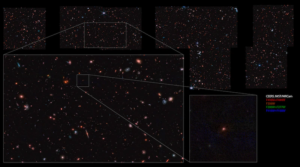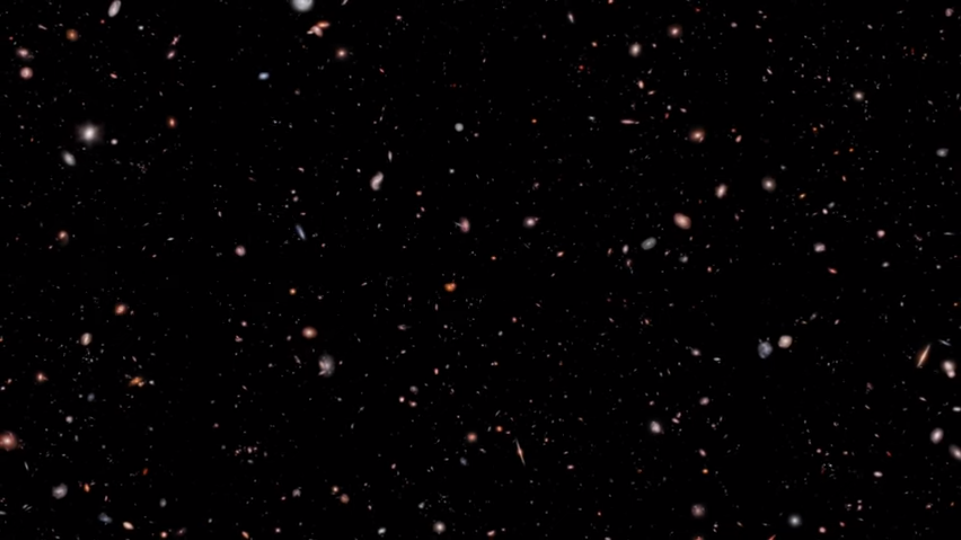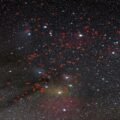A newly released video from NASA that utilizes data from the Hubble and James Webb Space Telescopes allows the viewer to travel 13.4 billion years back in time.
Part of NASA’s CEERS (Cosmic Evolution Early Release Science) survey, the visually stunning video passes through over 5,000 galaxies before ending on the earliest galaxy ever seen by humans, a galaxy created only 390 million years after the Big Bang.
Witness the Earliest and Most Distant Galaxy Ever Observed
In 2022, researchers using the James Webb Space Telescope spotted light from a galaxy so far away that it had never been seen before. Dubbed Maisie’s Galaxy in honor of project head Steve Finkelstein’s daughter, Maisie’s galaxy was formed only about 390 million years after the Big Bang, or about 13.4 billion years back in time. The discovery was made possible due to Webb’s ability to see in the infrared, something Hubble simply could not do.
“With Webb, we’re looking at part of the universe we’ve never seen before, even with Hubble,” said L. Y. Aaron Yung, a member of the discovery team and a postdoctoral fellow at NASA’s Goddard Space Flight Center at the time of the discovery. “Such early galaxies change our understanding of how galaxies form and the universe’s history.”


Now, NASA has utilized this data from Webb and combined it with observations from Hubble taken in 2004 and 2005 to create a visualization that transports the viewer through space and time all the way back to Maisie’s beginnings.
Video Transports the Viewer 13.4 Billion Years Back in Time
On July 10th, NASA released the video to the world, which allows the viewer to travel through the cosmos before landing on the image of Maisie’s Galaxy.
Need a calming moment? Wander leisurely through thousands of galaxies with this visualization from @NASAWebb. You’ll even see Maisie’s Galaxy, a bright, extremely distant galaxy discovered by Webb: https://t.co/yFdic7A5sC pic.twitter.com/L95ryYA9Nh
— NASA (@NASA) July 10, 2023
In a press release from the space administration, NASA notes that each second of the video “amounts to traveling 200 million years” into the past for a total of 13.4 billion years back in time. As Doc Brown from Back to the Future might say, Great Scott!
“We couldn’t study galaxies like Maisie’s before because we couldn’t see them,” said Rebecca Larson of the Rochester Institute of Technology, one of the survey’s investigators. “Now, not only are we able to find them in our images, we’re able to find out what they’re made of and if they differ from the galaxies that we see close by.”
During the video, the viewers travel through a part of space known as the Extended Groth Strip, which is home to about 100,000 galaxies. For this video, about 5,000 of those galaxies are visualized, leading the viewer on a cosmic journey back in time before landing on Maisie’s Galaxy.
“This observation exceeded our expectations,” said Finkelstein, a researcher from the University of Texas at Austin. “The sheer number of galaxies that we’re finding in the early universe is at the upper end of all predictions.”
James Webb Is Just Getting Started
Although an impressive display, the video from NASA is just a sample of the exciting things to come from the James Webb team.
This includes efforts to search for signs of extraterrestrial life in the Trappist-1 exoplanetary system and other tantalizing targets, as well as even more work to drill down into the data to separate out individual stars in the extremely ancient galaxies. According to researchers, it is work they are anxious to continue.
“We’re used to thinking of galaxies as smoothly growing,” said Finkelstein. “But maybe these stars are forming like firecrackers. Are these galaxies forming more stars than expected? Are the stars they’re making more massive than we expect? These data have given us the information to ask these questions. Now, we need more data to get those answers.”
Christopher Plain is a Science Fiction and Fantasy novelist and Head Science Writer at The Debrief. Follow and connect with him on Twitter, learn about his books at plainfiction.com, or email him directly at christopher@thedebrief.org.

